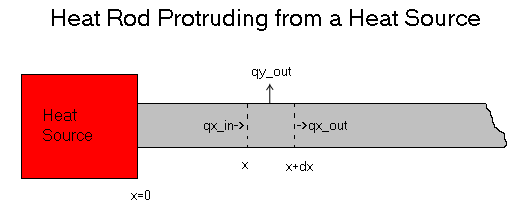

Here we generate the General Form for an equation of a heated rod. This
equation is general for rods of different cross sectional areas (and shapes).
We take the liberty of a couple simplifications which will be removed later.
> restart;
The heat flux entering a cross section is controlled by
the cross section the heat is fluxing though
the temperature difference across the delta X in the rod
the heat transfer coefficient
> qx_in:=-k*SA*diff(T(x),x);
![]()
Some of this heat exits the rod vertically and is controlled by
the surface area of the exposed rod Circumference*delx
the temperature difference between the surface and the air
the surface heat transfer coefficient.
> qy_out:=h*C*(T(x)-Tenv)*delx;
![]()
The third part of the heat flux is the remaining heat that isn't
lost from the surface and continues through the rod.
This equation has the same parameters as the qx_in equation.
> qx_out:=-k*SA*(diff(T(x),x)+diff(T(x),x,x)*delx);
![[Maple Math]](images/proj13.gif)
The definition of Steady State Heat Transfer, In+Out+Accumulated = 0
> SSHeatFlow:=qx_in-qx_out-qy_out=0;
![[Maple Math]](images/proj14.gif)
> SSHeatFlow:=simplify(SSHeatFlow/delx);
![[Maple Math]](images/proj15.gif)
Here we redefine our Temperature equation. Instead of having it be pure temperature, it will just be the temperature difference with respect to the outside air.
> T(x):=Theta(x)+Tenv;
![]()
> SSHeatFlow:=simplify(SSHeatFlow);
![[Maple Math]](images/proj17.gif)
Here we introduce a constant m = sqrt[( h*C)/(k*A)] for simplification.
> h:=k*m^2*SA/C;
![[Maple Math]](images/proj18.gif)
> SSHeatFlow:=simplify(SSHeatFlow/k/SA);
![[Maple Math]](images/proj19.gif)
>
s:=dsolve(SSHeatFlow,Theta(x)):
> t:=convert(s,exp);
![[Maple Math]](images/proj110.gif)
> simplify(t);
![]()
> GenForm:=Theta(x)=M*exp(-m*x)+N*exp(m*x);
![]()
Here these constants of integration are dependant on the boundary conditions of the system, otherwise this is the "general form" of the solution. (p208-209)
M = (C2 - C1)/2
N=(C1 + C2)/2;
Now we take the case of an "infinite rod", i.e. the length is infinite.
The Boundary Conditions.
@x = 0
Theta = Theta0
@x = infinity Theta = 0;
>
u:=dsolve({SSHeatFlow, Theta(0)=Theta[0], Theta(infinity)=0},Theta(x)):
v:=simplify(convert(u,exp),assume=positive);
![]()
Assume that we have two "very long" rods of the same shape, but different compositions, so we have: k1,k2 and h1,h2
Assume all other conditions are the same.
>
assign(v);
>
Theta:=unapply(Theta(x),x,m):
>
eq5:=Theta(m[1],x[1])=Theta(m[2],x[2]);
![]()
Now we substitute back in for our m variable, so we can do a deeper analysis.
>
unassign('h');
m[1]:=sqrt(h[1]*C/k[1]/SA);
m[2]:=sqrt(h[2]*C/k[2]/SA);
![[Maple Math]](images/proj115.gif)
![[Maple Math]](images/proj116.gif)
> eq6:=simplify(eq5/Theta[0],assume=positive);
![[Maple Math]](images/proj117.gif)
Because Maple has problems simplifying equations, we'll just manually retype it in here with our simplifications.
> eq7:=x[1]*sqrt(C*h[1]/k[1]/SA)=x[2]*sqrt(C*h[2]/k[2]/SA);
![[Maple Math]](images/proj118.gif)
> eq8:=k[1]=solve(eq7,k[1]);
![[Maple Math]](images/proj119.gif)
Now we have two rods with the same Circumference and Cross Sectional Area.
> eq8:=simplify(eq8/k[2],assume=positive);
![[Maple Math]](images/proj120.gif)
Thus we have a quantitative way of measuring the thermal conductivity of rods. Knowing the thermal conductivity and the surface conductivity for two rods of equal dimensions we can find at what lengths they have the same temperature.
>
However this is a little less useful. It would instead be easier to measure the temperature at two points of equal length on a rod, and then equate them to solve for the relationship between their surface and internal heat coefficients.
>
eqn1:=Theta[1]=Theta[0]*exp(-m[1]*x);
eqn2:=Theta[2]=Theta[0]*exp(-m[2]*x);
![[Maple Math]](images/proj121.gif)
![[Maple Math]](images/proj122.gif)
Solve for x and substitute it into the second equation.
>
x:=solve(eqn1,x);
simplify(eqn2,assume=positive);
![[Maple Math]](images/proj123.gif)
![[Maple Math]](images/proj124.gif)
> k[1]:=solve(eqn2,k[1]):
> eqn3:=k1/k2=k[1]/k[2];
![[Maple Math]](images/proj125.gif)
Here we have a relationship between the temperature differences and the heat transfer coefficients. We can simplify this equation further by having two rods (of different compositions) with surfaces that have been polished so that both are approximately of the same smoothness. While they may not be exactly the same, we will have two surface heat transfer coefficients that are close enough to assume that they are the same. Then we will have an equation that is only a function of distance and heat transfer coefficients. From this we can generate a whole table of relative values for the transfer coefficient.